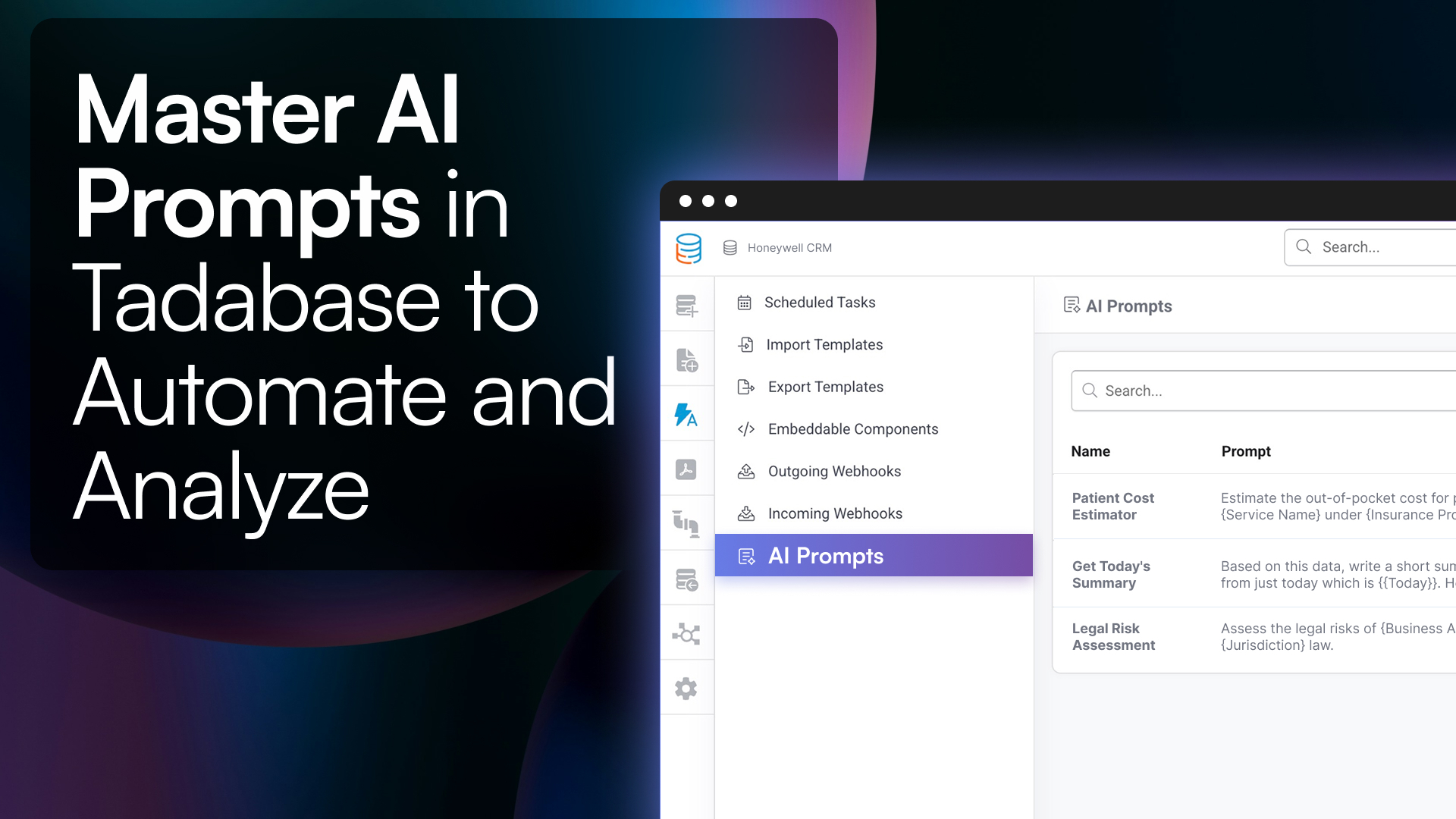HTML, CSS, and JavaScript create the structure, style, and interactivity essential for advanced web applications.
Introduction
In web development, HTML, CSS, and JavaScript go beyond static site creation; they’re essential for building dynamic applications that handle complex data and interactions. For advanced users, these tools form the foundation of scalable, data-driven applications. Tadabase, a no-code platform, enhances this potential by seamlessly integrating custom HTML, CSS, and JavaScript into its framework. This guide covers advanced techniques and Tadabase-specific best practices for creating robust, performant applications that align with business needs and brand identity. For beginners, check out our article, HTML, CSS, and JavaScript Explained (with analogies).
Structuring Data-Driven Pages with Advanced HTML
Using HTML for Dynamic and Accessible Data Presentation
In complex applications, HTML is more than just a layout tool; it organizes and presents data in a structured, accessible way. Here’s how to maximize HTML within Tadabase:
-
Data Attributes for Dynamic Content
- Leverage
data-*attributes to store dynamic metadata on HTML elements. In Tadabase, this is ideal for associating data IDs, user roles, or other contextual data with elements, enabling rich interactivity via JavaScript.
<div class="user-profile" data-user-id="123" data-role="admin"> <h2>User Profile</h2> </div>
- Pro Tip: Combine data attributes with JavaScript for filtering, dynamically displaying data, or adjusting layouts based on user roles.
- Leverage
-
Semantic HTML for Accessibility and SEO
- Use semantic tags like
<main>,<header>, and<section>to improve readability and accessibility. This approach enhances both the application’s SEO and its accessibility, especially within Tadabase’s Data Components. - Example:
<header><h1>Dashboard</h1></header> <section id="summary"> <h2>Summary</h2> </section>
- Use semantic tags like
-
Enhanced Structuring with Tadabase’s Layout Builder
- Tadabase’s Layout Builder enables HTML structuring without redundant markup. This drag-and-drop feature aligns HTML tags with component structures, creating a clean, organized layout.
- Learn more about the Layout Builder here
Advanced Styling Techniques with CSS
Leveraging CSS for Consistent and Responsive Application Design
-
Custom Themes with CSS Variables
- Define a brand-aligned theme using CSS variables, applying a consistent color palette across your application. This method makes it easy to adjust your theme globally as needed.
:root { --primary-color: #4a90e2; --secondary-color: #f4f4f9; } .button { background-color: var(--primary-color); color: #fff; } -
Responsive Layouts with CSS Grid and Flexbox
- Use Flexbox and CSS Grid to create responsive, adaptable layouts. Flexbox is perfect for aligning items within rows or columns, while CSS Grid enables complex, multi-dimensional layouts for data-rich pages.
-
Global CSS Customization in Tadabase
- Tadabase’s global CSS settings allow you to apply consistent styles across tables, forms, and action buttons, maintaining a cohesive brand identity.
- Explore CSS customization tips in Tadabase’s documentation
Adding Interactivity and Automation with JavaScript
Advanced JavaScript for Real-Time User Interaction and Data Management
-
Dynamic DOM Manipulation for Live Updates
- Use JavaScript to update content dynamically in response to user actions. This technique is particularly useful for real-time dashboards or conditional displays.
document.querySelectorAll('.status').forEach(element => { if (element.dataset.status === 'inactive') { element.style.color = 'red'; } }); -
Event Listeners for Enhanced Interactivity
- Event listeners enable interactions like data filtering, sorting, and live data updates, which are essential for data-rich applications.
document.querySelector('.filter-button').addEventListener('click', function() { // Apply custom filtering logic here }); -
Integrating JavaScript with Tadabase API
- Extend Tadabase’s API with JavaScript to dynamically fetch, sort, or filter data without reloading the page.
fetch('https://api.tadabase.io/data') .then(response => response.json()) .then(data => { document.querySelector('.data-container').textContent = JSON.stringify(data); });
Managing Data and Security in Tadabase
Best Practices for Data Structuring and Secure Access
-
Optimizing Data Tables and Relationships
- Efficiently structure data tables and relationships using Tadabase’s Data Builder, which helps streamline queries and enhance performance.
- Read more on efficient structuring
-
User Role Permissions for Secure Access
- Configure Tadabase to restrict data access based on user roles, an essential step for applications handling sensitive information.
- Learn how to configure permissions
-
Regular Backups and Data Encryption
- Enable regular backups for data integrity and set up encryption for sensitive data fields.
- Explore Tadabase’s backup and encryption options
Performance Optimization Tips for Tadabase Applications
Techniques to Keep Your Application Fast and Efficient
-
Conditional Loading for Heavy Components
- Use Tadabase’s conditional loading to defer data-heavy components until necessary, improving page load times.
-
Optimize Media for Speed
- Resize and compress media files before uploading to Tadabase, reducing load times on all devices, particularly mobile.
-
Monitor and Analyze Performance
- Leverage Tadabase’s built-in analytics to track load times, usage patterns, and bottlenecks.
Extending Tadabase Applications with Integrations
Expanding Functionality through Third-Party Integrations
-
Workflow Automation with Zapier and Integromat
- Integrate Tadabase with platforms like Zapier and Integromat to automate processes such as notifications, data syncing, and reporting.
-
Embedding External Components with iFrames
- Use iFrames to embed third-party tools or dashboards directly into Tadabase.
-
Custom API Integrations for Advanced Functionality
- For applications requiring complex data interactions, use Tadabase’s API to integrate with external systems.
- Explore Tadabase’s API for custom functionality
White Labeling and Complete Branding Control
Tadabase offers full white labeling, enabling you to create applications that look and feel fully branded. With options to customize URLs, logos, colors, and more, you can deliver a cohesive, professional-grade experience tailored to your organization’s identity.
Conclusion
Advanced HTML, CSS, and JavaScript techniques empower Tadabase users to build high-performing, customized applications. By combining Tadabase’s no-code capabilities with custom code, you can create efficient, scalable, and secure applications that align with your brand and meet complex needs.
Start your free trial today and explore the possibilities for dynamic, data-driven applications.
Frequently Asked Questions
Q1: What are the primary benefits of using custom HTML, CSS, and JavaScript in Tadabase applications?
Using custom HTML, CSS, and JavaScript in Tadabase allows you to extend the platform’s default functionality. HTML provides the structure for dynamic data representation, CSS enables detailed control over styling, and JavaScript brings interactivity, such as real-time updates and user-triggered actions. Together, these technologies allow you to create tailored, branded, and highly functional applications.
Q2: How can HTML data attributes enhance a Tadabase application?
HTML data attributes (e.g., data-*) store additional data within HTML elements without impacting the layout. In Tadabase, they’re useful for storing metadata like IDs, user roles, or statuses, which can be referenced by JavaScript to enable dynamic interactions such as filtering or conditional display based on specific data values.
Q3: What is semantic HTML, and why is it important in Tadabase applications?
Semantic HTML uses meaningful tags like <header>, <section>, and <footer> that describe their content, improving accessibility for screen readers and aiding search engine optimization (SEO). This is especially valuable in Tadabase’s data-driven applications as it ensures a clear content structure, helping screen readers and improving navigation within Data Components.
Q4: How can CSS variables improve the styling of a Tadabase application?
CSS variables (custom properties) allow you to define a color palette or consistent design elements across your application. By using variables, you can make global updates to color schemes or styling, ensuring brand consistency and simplifying theme adjustments across Tadabase components.
Q5: What are the benefits of using CSS Grid and Flexbox in Tadabase?
CSS Grid and Flexbox provide powerful layout options for responsive and adaptable designs. Flexbox is useful for distributing items within rows or columns, while CSS Grid is ideal for creating complex layouts like dashboards or multi-column data displays. These are especially beneficial in Tadabase for creating dynamic, user-friendly layouts that adapt to various screen sizes.
Q6: How does Tadabase’s Global CSS feature support brand consistency?
Global CSS in Tadabase allows you to define and apply consistent styles across tables, forms, buttons, and other components. This centralizes your styling, making it easier to maintain a cohesive look throughout your application and ensuring brand identity is preserved.
Q7: What are common JavaScript use cases in Tadabase applications?
JavaScript in Tadabase can be used for DOM manipulation (updating the page content dynamically), adding event listeners for user actions, and calling Tadabase’s API for real-time data fetching and updating. These features enable advanced functionality, such as filtering, sorting, and interactive content that responds to user input.
Q8: Can I make API calls directly from Tadabase using JavaScript?
Yes, you can use JavaScript to make API calls directly within Tadabase. By leveraging Tadabase’s API, you can dynamically retrieve or update data based on user actions, enhancing application interactivity and providing real-time data updates without reloading the page.
Q9: How can I secure sensitive data in Tadabase applications?
For data security, Tadabase offers field-level encryption for sensitive information like personally identifiable information (PII) or financial data. Additionally, you can set up role-based permissions to restrict data access to authorized users only, which is crucial for applications handling confidential information.
Q10: What best practices can improve data structure efficiency in Tadabase?
Use Tadabase’s Data Builder to create well-organized data tables with clear relationships, avoiding redundant joins. Structuring your data tables effectively reduces query complexity, resulting in faster data retrieval and improved application performance.
Q11: How does Tadabase’s Layout Builder enhance HTML structuring?
The Layout Builder in Tadabase allows for a structured layout without unnecessary markup, letting you create and manage layouts easily with drag-and-drop functionality. This helps you keep HTML organized and maintainable, especially in applications that require clean, data-rich displays.
Q12: Can I automate workflows in Tadabase with third-party tools?
Yes, Tadabase integrates with automation platforms like Zapier and Integromat, allowing you to automate workflows across multiple applications. Common tasks include triggering notifications, syncing data, and handling form submissions, which streamlines processes and reduces manual effort.
Q13: How does white labeling work in Tadabase?
Tadabase offers complete white labeling, enabling you to create applications that look fully branded. You can customize URLs, logos, colors, and more, delivering a cohesive, professional experience tailored to your organization’s brand.
Q14: What is conditional loading, and why is it important for performance?
Conditional loading in Tadabase delays the loading of data-heavy components until they’re needed. This optimizes initial page load times, particularly beneficial for users on mobile devices or applications with complex data tables or dashboards, ensuring a faster, smoother experience.
Q15: How can I monitor application performance in Tadabase?
Tadabase provides built-in analytics tools to track key performance metrics, such as page load times, data usage, and user engagement. Regularly monitoring these metrics helps you identify potential bottlenecks, allowing you to optimize your application and improve the user experience.
Q16: What are some ways to optimize media in Tadabase for faster loading?
To optimize media, resize and compress images, videos, and other large files before uploading them to Tadabase. Smaller file sizes reduce load times and improve performance, especially for users accessing applications on mobile devices.
Q17: What is the best way to manage backups in Tadabase?
Tadabase supports regular data backups, which can be configured through its settings. Regular backups ensure data reliability and can prevent data loss. Tadabase also provides options for restoring from backup logs if necessary.
Q18: How do I customize forms and buttons for a unified look across Tadabase components?
Use Tadabase’s Global CSS to define consistent styles for forms, tables, buttons, and other components, ensuring a cohesive design. Additionally, Tadabase’s settings allow you to adjust colors, fonts, and other elements, aligning the entire application with your brand.
Q19: Can I embed third-party tools directly within my Tadabase application?
Yes, Tadabase supports embedding external tools or dashboards using iFrames, allowing you to incorporate analytics, chat features, or other interactive components seamlessly into your application.
Q20: What are some advanced API use cases within Tadabase?
Advanced API use cases include real-time data syncing, automating bulk data updates, and connecting Tadabase with other systems to create an integrated solution. Tadabase’s API allows for programmatic data management, making it versatile for complex applications needing custom functionality.









